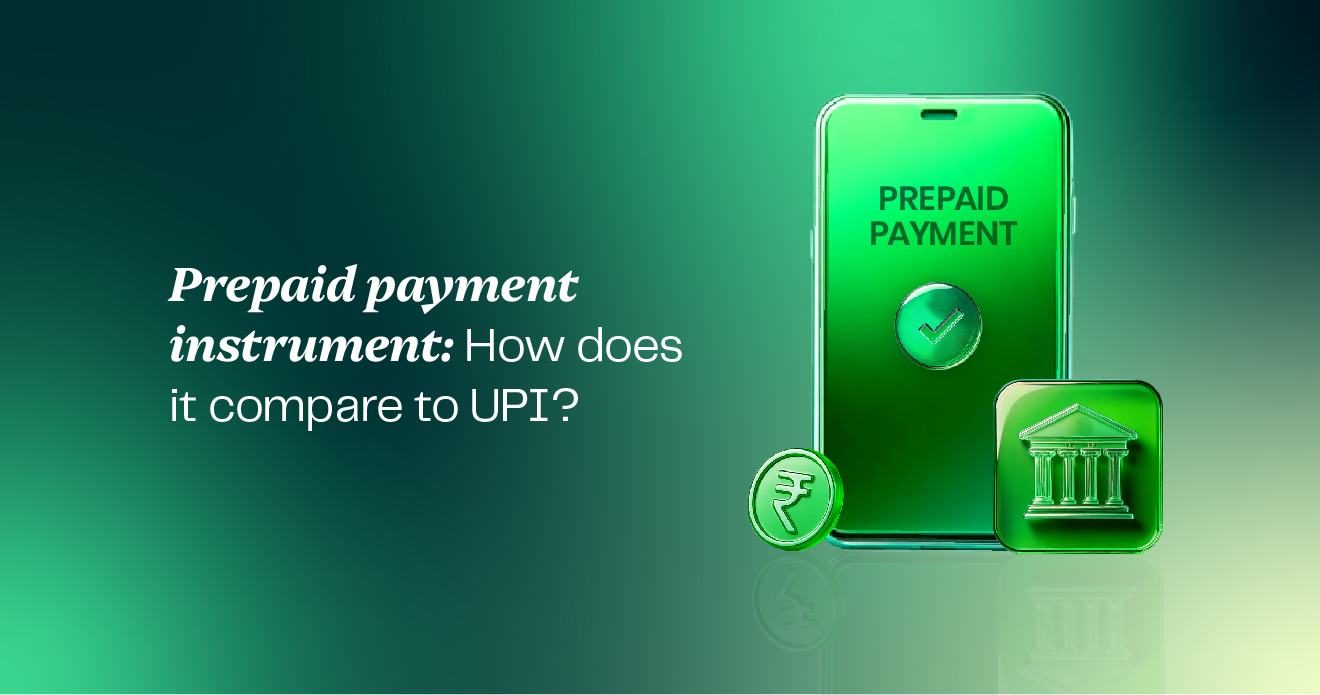Today’s digital economy sees both consumers and businesses seeking convenient, secure and versatile payment solutions. Two prominent modes that have transformed the financial transaction world in India are the prepaid payment instrument and the Unified Payments Interface (UPI). While both have their unique value propositions, understanding their key differences can help individuals and organisations choose the right solution for their payment needs.
This blog explores what prepaid payment instruments are, how they work and how they compare with UPI in terms of usability, security, reach and flexibility. It will also explore UPI vs PPI in detail.
What is a prepaid payment instrument?
A prepaid payment instrument (PPI) is a method of storing monetary value in advance for conducting transactions at authorised merchants or platforms. It acts as a pre-funded wallet or card, eliminating the need to link a bank account at the time of payment. These instruments include prepaid cards, digital wallets, vouchers and gift cards.
PPIs offer users a convenient, controlled and secure way to manage their finances—making them particularly effective for budget-conscious consumers and businesses that require scalable payment solutions.
Key benefits of prepaid payment instruments
The popularity of prepaid payment instruments lies in their distinctive benefits:
- Financial control: Users can only spend what has been preloaded, making it easier to manage expenses.
- Increased security: Since transactions do not require direct bank account access, the risk of sensitive data exposure is significantly reduced.
- Accessibility: Ideal for the unbanked or underbanked populations who may not have traditional banking access.
- Versatility: Accepted across a range of merchants and use cases—online shopping, gifting, employee benefits, travel and more.
- Convenient reusability: Most PPIs are reloadable, enabling repeated usage without the need for reissuance.
Types of prepaid payment instruments and their uses
Different types of prepaid payment instruments are designed to suit various user needs and business models. Here’s an overview:
- Closed system PPIs
These can only be used with the issuing entity. For example:
- Retail gift cards: Valid only within the same brand’s ecosystem.
- Digital vouchers: Typically offered for promotions and redeemable against specific products or services.
- Semi-closed system PPIs
These can be used across multiple merchants that have a contract with the issuer. They can be widely used for payments in retail chains, food courts and online platforms.
- Open system PPIs
These allow usage across any merchant that accepts card payments, similar to debit or credit cards.
- Reloadable prepaid cards: Suitable for both online and in-store transactions.
- Travel cards: Preloaded with multi-currency options, ideal for international travel and expense management.
- Mobile wallets
Digital wallets enable contactless payments via smartphones and integrate easily with various payment systems, offering speed and convenience.
Use cases of prepaid payment instruments
Prepaid payment instruments have broad application across sectors:
- Everyday purchases: Useful for groceries, dining, fuel and more.
- E-commerce: Secure and easy transactions for online shopping and subscriptions.
- Corporate gifting: Gift cards and vouchers for employees, clients or channel partners.
- Travel: Streamlined expense control through travel-specific PPIs.
- Employee benefits: Meal cards, reward cards and incentive programmes.
- Financial inclusion: Enables micro-transactions and helps bring unbanked populations into the digital financial ecosystem.
UPI vs PPI: A comparative overview
While both UPI and PPIs simplify transactions, they differ in infrastructure, user experience and applicability. Below is a comparative table to highlight key differences:
| Feature | Prepaid Payment Instrument (PPI) | Unified Payments Interface (UPI) |
| Bank account requirement | Not required | Mandatory |
| Fund source | Preloaded funds | Directly linked bank account |
| Transaction speed | Instant, but it depends on merchant integration | Real-time |
| Security | Limited risk exposure; not bank account-linked | Bank account linked; requires multi-factor authentication |
| Usage scope | Varies by type (closed/semi/open/mobile wallet) | Universally accepted across UPI-enabled platforms |
| Reloading mechanism | Manual top-up required | Fund availability based on bank balance |
| Ideal use case | Gifting, budgeting, financial inclusion, rewards | P2P transfers, bill payments, retail purchases |
Why prepaid payment instruments matter in a digital-first era
As digital transactions continue to grow, prepaid payment instruments have become vital tools for both consumers and businesses. While UPI has transformed real-time payments, PPIs offer structured control, making them ideal for incentives, rewards and secure purchases. Organisations can use PPIs to enable controlled payments without exposing core accounts, while consumers benefit from better budgeting and secure spending.
Rather than viewing UPI and PPIs as competing solutions, businesses should see them as complementary. UPI is perfect for instant transfers and utility bills, while PPIs excel in loyalty programmes, employee benefits and promotional campaigns. Together, they create a more advanced and versatile payment ecosystem tailored to evolving customer needs.
How Pine Labs is shaping the future of prepaid payment instruments
Pine Labs is redefining the prepaid payment scenario with innovative solutions tailored to modern business needs. From gift cards and digital vouchers to corporate prepaid offerings, Pine Labs’ Prepaid serves industries like retail, hospitality, travel and education. Qwikcilver supports issuance, redemptions, cashback, refunds, promotions and loyalty—all within a unified ecosystem.
With advanced APIs, omnichannel compatibility and seamless integrations, Qwikcilver empowers brands to deliver versatile, scalable and engaging payment experiences. Pine Labs’ Prepaid is shaping the future of digital payments through powerful, customer-centric prepaid solutions.
Choosing the right payment method for your needs
Choosing between UPI and PPI largely depends on the user context. While UPI is ideal for instant, bank-linked transfers, prepaid payment instruments offer greater control, security and flexibility—especially in structured or commercial settings. For businesses seeking to enhance customer engagement, manage expenses efficiently or drive new revenue opportunities, PPIs provide a forward-thinking solution.
At Pine Labs, along with our prepaid solutions arm Pine Labs Prepaid, we are proud to lead this shift in the digital payments ecosystem. Our innovative, scalable and future-ready PPI offerings are designed to deliver real impact—helping organisations manage today’s payment world with greater confidence and success. Learn more about Pine Labs at https://www.pinelabs.com/.

